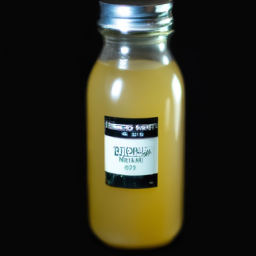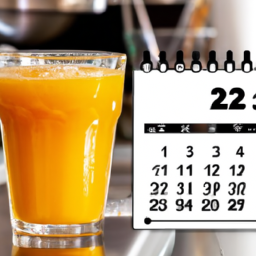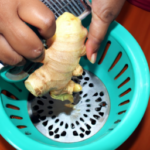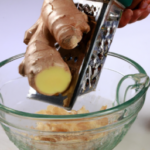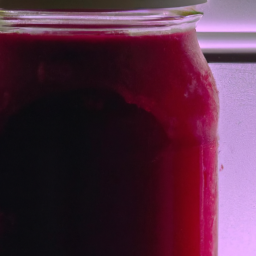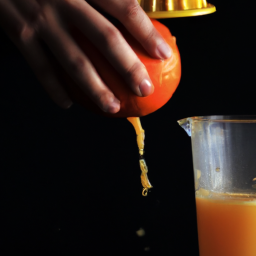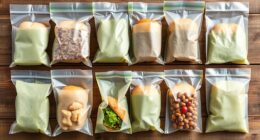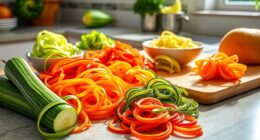As someone who loves adding ginger to my meals and drinks, I have frequently wondered how long ginger juice stays fresh and safe to consume. Ginger juice, a concentrated blend made from ginger root, is praised for its bold flavor and numerous health benefits. However, like all perishable goods, ginger juice has a limited shelf life, with its quality and safety potentially decreasing over time.
In this article, I will explore the factors that affect the shelf life of ginger juice, how to tell if it is still fresh, and the best ways to store it to extend its lifespan.
Ginger juice can be made at home or bought from a store, but its shelf life varies depending on its freshness and storage conditions. As someone who prefers making my own ginger juice, I am curious about how long it can last without losing its flavor and nutritional value. Spoiled ginger juice can cause foodborne illnesses, such as vomiting and diarrhea, so it is crucial to understand the signs of spoilage and safety concerns.
By learning how to store ginger juice properly, we can ensure that it remains fresh for longer, and we can continue to enjoy its spicy kick and health benefits.
Key Takeaways
- Fresh ginger juice can last about a week in the fridge
- Homemade ginger juice is healthier and more cost-effective than store-bought options that may contain additives and preservatives
- Signs of spoiled ginger juice include discoloration and unusual odors, and it should not be consumed if left at room temperature for more than two hours
- Freezing ginger juice can extend its shelf life for several months, but the texture and taste may change slightly after thawing.
Understanding the Shelf Life of Ginger Juice
Ginger juice’s shelf life can vary depending on how it’s stored, but it typically lasts for about a week in the refrigerator. The shelf life factors include the quality of the ginger used, the processing method, and the storage conditions. To preserve the nutrients in ginger juice for a longer time, it’s recommended to store it in an airtight container in the refrigerator.
It’s important to note that the fresher the ginger used to make the juice, the longer its shelf life. Store-bought ginger juice may have preservatives added to extend its shelf life, which can affect the quality of the juice and reduce its nutrient content.
In the next section, we’ll compare fresh ginger juice to store-bought ginger juice.
Fresh vs. Store-Bought Ginger Juice
Contrary to popular belief, store-bought ginger juice may not be as fresh as its homemade counterpart. While it may be convenient to grab a bottle of ginger juice from the grocery store, it’s important to note that most store-bought options contain preservatives and additives to prolong their shelf life. These additives can take away some of the health benefits that ginger juice is known for.
When it comes to homemade options, you have more control over the freshness and quality of your ginger juice. You can ensure that you’re using fresh ginger root and other natural ingredients without any preservatives or additives. Additionally, homemade ginger juice can be customized to your liking, whether you prefer it sweeter or spicier. Overall, making ginger juice at home is a healthier and more cost-effective option compared to store-bought varieties.
Moving forward, it’s important to understand how long fresh ginger juice can last before it goes bad.
How Long Does Fresh Ginger Juice Last?
So, I’ve been experimenting with making fresh ginger juice at home lately, and I’ve been wondering about its shelf life.
After doing some research, I’ve learned that there are three main ways to store fresh ginger juice: refrigeration, freezing, and leaving it at room temperature.
Each method has its own pros and cons, and it’s important to understand the best way to store your ginger juice to ensure its freshness and potency.
Refrigeration
If you want to keep your ginger juice fresh, you should refrigerate it promptly and consume it within a few days. Refrigeration slows down the oxidation process, which can cause the juice to spoil quickly.
Moreover, refrigerated ginger juice has its benefits. It can help to soothe digestive problems, reduce inflammation, and even boost the immune system. Drinking it cold can also be refreshing and revitalizing.
There are several ways to consume refrigerated ginger juice. You can drink it straight up or mix it with water, honey, lemon, or other ingredients to create a tasty and healthy beverage. You can also use it as a marinade or dressing for salads, meats, or vegetables.
Whatever way you choose, make sure to consume it within a few days to ensure its freshness.
Now, let’s move onto the next step and learn how to freeze ginger juice.
Freezing
When you’re ready to preserve your ginger elixir for future use, pop it in the freezer and transform it into a refreshing treat that will make you feel like you’re sipping on a frosty summer drink. Freezing ginger juice is an effective method of long term storage that can extend its shelf life for several months. However, it’s important to note that the texture and taste may change slightly after thawing, so it’s best to use it in recipes rather than drinking it straight.
To help you determine how long your frozen ginger juice will be good for, refer to the table below. Keep in mind that these are general guidelines and the actual shelf life may vary depending on factors such as the freshness of the ginger and the temperature of your freezer.
| Freezer Temperature | Shelf Life |
|---|---|
| 0°F or colder | 8-12 months |
| 32°F to 0°F | 3-6 months |
| Above 32°F | Not recommended for freezing |
Moving on to the next section, let’s explore the impact of room temperature on the shelf life of ginger juice.
Room Temperature
Now that you’ve learned about freezing, let’s talk about how leaving your ginger elixir at room temperature can affect its freshness and taste. When ginger juice is stored at room temperature, it can last for up to five days. This is because the microorganisms in the juice grow faster in warmer temperatures, leading to spoilage.
However, there are also benefits to keeping ginger juice at room temperature. It can enhance the flavor and aroma of the juice, making it more enjoyable to drink. Additionally, room temperature ginger juice is easier to digest, as the warmth can help to stimulate the digestive system.
To ensure that your ginger juice stays fresh at room temperature, it is important to store it in the right container. Glass bottles or jars with tight-fitting lids are the best option, as they prevent air and moisture from getting in. Plastic containers can also work, but make sure they are BPA-free and have airtight seals. Avoid storing ginger juice in metal containers, as they can react with the juice and affect its taste.
It is also important to keep the ginger juice away from direct sunlight and heat sources, as this can cause the juice to spoil faster. Now that you know how to store your ginger juice at room temperature, it’s important to know the signs of spoiled juice. This will help you to avoid drinking juice that has gone bad, which can cause digestive problems.
Signs of Spoiled Ginger Juice
Beware of the ginger juice that’s turned into a stinky swamp, as it’s a sure sign that it’s time to toss it out. Discoloration and unusual odors are the primary indicators that ginger juice has gone bad.
Common contaminants, such as bacteria and mold, can develop in the juice and pose health risks to those who consume it. To avoid these safety concerns, it’s crucial to store ginger juice properly and check for signs of spoilage regularly.
Keep the juice refrigerated and consume it within a few days of making it. If the juice appears cloudy or has a foul odor, don’t take any chances and discard it immediately.
By taking these precautions, you can enjoy the benefits of ginger juice without any health risks.
Safety Concerns
It’s crucial to store ginger juice properly and regularly check for signs of spoilage to ensure your safety, especially since ginger juice consumption has been linked to various health benefits. Here are some safety concerns to keep in mind when handling ginger juice:
-
Avoid consuming ginger juice that’s been left at room temperature for more than two hours as it may harbor harmful bacteria.
-
Be aware of any allergic reactions or side effects that may occur after consuming ginger juice, such as heartburn or allergic reactions.
-
Always wash your hands and all equipment thoroughly before handling ginger root and making ginger juice to prevent contamination.
-
Consult a healthcare professional before incorporating ginger juice into your diet, especially if you have any underlying medical conditions or are taking medications.
Taking these safety concerns into account can help prevent any potential health risks associated with ginger juice consumption.
Keep reading for tips on how to properly store ginger juice.
Tips for Storing Ginger Juice
When it comes to storing ginger juice, it’s important to choose the right container that will keep the juice fresh for as long as possible. Labeling and dating the container will also help you keep track of how long the juice has been stored and when it needs to be used by.
Freezing and thawing is another option for storing ginger juice, but it’s important to follow proper procedures to ensure the juice retains its quality and taste.
Choosing the Right Container
To keep your ginger juice fresh, you’ll want to choose a container that has an airtight seal and is made of glass or BPA-free plastic. Here are some things to consider when choosing the right container:
-
Glass vs. plastic: Glass is a great option as it’s non-reactive and doesn’t contain any harmful chemicals that can leach into your juice. Plastic, on the other hand, can be a good option if it’s BPA-free and made of high-quality materials that won’t break down over time.
-
Airtight vs. non-airtight: It’s important to choose a container that has an airtight seal to prevent air from getting in and oxidizing the ginger juice. This will help keep the juice fresh for longer and preserve its flavor and nutrients. Non-airtight containers may be okay for short-term storage, but they’re not ideal for long-term use.
-
Size: Choose a container that’s just the right size for your needs. A container that’s too small will leave too much air in the container, while a container that’s too big will leave too much space for air to circulate, which can lead to spoilage.
-
Durability: Look for a container that’s durable and can withstand the rigors of daily use. Glass containers are generally more durable than plastic ones, but high-quality plastic containers can also be quite durable.
When you’ve chosen the right container, the next step is to label and date your ginger juice to keep track of its freshness.
Labeling and Dating
Once you’ve got your airtight glass or BPA-free plastic container, make sure to label it with the date. This will help you keep track of how fresh your zesty ginger elixir is and ensure that you consume it before it goes bad.
Labeling your ginger juice is crucial, as it can last up to a week in the fridge, but its shelf life depends on how fresh the ginger root was when juiced. When labeling your ginger juice container, include the date you made it and the expiration date. This will help you keep track of how long your ginger juice has been in the fridge and when it will expire.
It’s important to be vigilant about labeling and expiration dates, as consuming ginger juice that has passed its expiration date can cause food poisoning.
If you’re wondering about freezing and thawing, that’s a topic for another discussion.
Freezing and Thawing
If you’re wanting to keep your zesty ginger elixir ready for whenever a ginger craving hits, freezing your ginger juice is a game-changer. Freezing technique not only preserves the juice’s flavor but also its nutrients for longer periods.
Here are three essential tips to freeze ginger juice effectively:
- Use an airtight container: It’s crucial to use an airtight container to prevent freezer burn and the juice’s contact with air, which can cause oxidation and spoilage.
- Leave some space at the top: Ginger juice expands when frozen, so it’s essential to leave some space at the top of the container to avoid any mess or spillage.
- Label and date the container: To keep track of the ginger juice’s age and freshness, label and date the container before freezing.
Thawing methods are just as crucial as freezing techniques in preserving the ginger juice’s quality. Avoid using a microwave to thaw frozen ginger juice as it can destroy the juice’s nutrients and alter its flavor. Instead, place the container in the fridge overnight or run it under warm water until it thaws.
Maintaining ginger juice’s freshness is a crucial aspect of enjoying its flavor and benefits. The next section will discuss how to tell if ginger juice is fresh, ensuring that you consume only the best quality ginger juice.
How to Tell if Ginger Juice is Fresh
You can easily determine if your ginger juice is fresh by looking at its color and smell. Fresh ginger juice should have a vibrant yellowish color, and it should smell strongly of ginger. If the juice has a brownish hue or a dull color, it may not be fresh.
Similarly, if the ginger juice doesn’t have a strong aroma, it may have lost its flavor and potency. Consuming fresh ginger juice has many health benefits. It can help alleviate symptoms of nausea, reduce inflammation, and aid in digestion.
To make fresh ginger juice at home, simply peel and grate fresh ginger root and then squeeze out the juice using a cheesecloth or a juicer. By using fresh ginger juice, you can enjoy all of the health benefits and delicious flavor that ginger has to offer.
When using ginger juice in recipes, it’s important to keep in mind that a little goes a long way. Ginger juice is a potent ingredient, so be sure to use it sparingly and adjust the amount to your taste. Adding too much ginger juice can overpower the other flavors in a dish.
Using Ginger Juice in Recipes
Now that we know how to tell if ginger juice is fresh and how long it’s good for, let’s discuss how to use it in recipes.
As someone who loves to experiment in the kitchen, I’ve found that ginger juice can add a wonderful burst of flavor to both savory and sweet dishes.
From stir-fries to smoothies, the possibilities are endless. Additionally, adding ginger juice to drinks like tea or lemonade can provide a refreshing and healthful twist.
Cooking with Ginger Juice
Using ginger juice in your cooking can add a unique and flavorful twist to your dishes, and it can last in the refrigerator for up to two weeks. Here are some tips on how to incorporate ginger juice into your recipes:
-
Marinades: Use ginger juice as a base for marinades. It adds a tangy and spicy flavor to meats and vegetables. Mix ginger juice with soy sauce, honey, and garlic for a delicious marinade for chicken or pork.
-
Dressings: Ginger juice can be used in salad dressings. Combine ginger juice with olive oil, lemon juice, and honey for a zesty dressing that pairs well with leafy greens.
-
Stir-fries: Add ginger juice to stir-fries for an extra kick. It goes well with vegetables such as broccoli, carrots, and snap peas.
-
Soups and stews: Use ginger juice to add flavor to soups and stews. It pairs well with chicken, beef, and seafood. Adding ginger juice to a chicken noodle soup can be a great way to clear a stuffy nose.
Adding ginger juice to drinks is another way to enjoy its benefits and unique flavor.
Adding Ginger Juice to Drinks
Looking to spice up your favorite beverages? Try incorporating some zingy ginger juice for a flavorful twist! Not only does ginger juice add a delicious flavor to drinks, it also offers a range of health benefits. From reducing inflammation to aiding digestion, ginger juice is a versatile ingredient that can be used in many different ways.
One popular way to enjoy ginger juice in drinks is by creating ginger juice cocktails. Mixing ginger juice with fresh herbs and fruits can create a refreshing and unique beverage. Additionally, adding a splash of ginger juice to your smoothies or juices can add a punch of flavor and nutrition. So next time you’re looking to mix up your drink game, consider adding some ginger juice to the mix. In the next section, we will explore alternative ways to consume ginger.
Alternative Ways to Consume Ginger
As I’m exploring the benefits of ginger, I’ve discovered two alternative ways to consume it: fresh ginger and dried ginger. Fresh ginger is commonly used in cooking and can be grated or sliced to add flavor to dishes.
Dried ginger, on the other hand, is often used in the form of a powder or supplement and can be added to teas or smoothies for a quick and easy way to consume it. Both forms of ginger have their own unique benefits and can be incorporated into a healthy diet.
Fresh Ginger
You may be surprised to learn that fresh ginger juice can stay good for up to a week if stored properly in the refrigerator. This is great news for those who want to incorporate ginger juice benefits into their daily routine without having to make it every day.
When juicing fresh ginger, it’s important to use proper juicing techniques to ensure the best quality juice. Start by washing the ginger root and cutting it into smaller pieces. Then, use a juicer to extract the juice from the ginger. The resulting juice can be consumed as is or mixed with other fruits and vegetables for added flavor and nutrients.
Fresh ginger juice is a great addition to any diet due to its numerous health benefits. It contains anti-inflammatory and antioxidant properties that can help reduce inflammation, boost immunity, and improve digestion. Additionally, it may even have anti-cancer properties.
So, if you want to reap the benefits of fresh ginger juice, remember to store it properly in the refrigerator and use it within a week. Now, let’s move on to the next section about dried ginger.
Dried Ginger
If you’re searching for a convenient way to enjoy the benefits of ginger, try incorporating dried ginger into your diet. Dried ginger is the dehydrated form of fresh ginger, and it has a longer shelf life than fresh ginger. You can use dried ginger in various ways in your cooking, such as in spice rubs, marinades, and baked goods. It adds a warm, slightly sweet, and mildly spicy flavor to dishes.
Dried ginger has many health benefits. It has anti-inflammatory and antioxidant properties, which may help reduce inflammation, lower cholesterol levels, and improve digestion. Additionally, it may have anti-cancer properties and help with pain relief. Incorporating dried ginger into your diet is an easy way to add flavor and nutrition to your meals. Just remember to store it in a cool, dry place, away from sunlight, to maintain its freshness.
Frequently Asked Questions
Can you freeze ginger juice for longer storage?
Oh my goodness, freezing ginger juice is a game changer! Not only does it extend the shelf life of this liquid gold, but it also preserves its potent anti-inflammatory properties. So go ahead, stock up and freeze away!
How often should you shake or stir ginger juice to ensure optimal freshness?
To ensure optimal freshness, I recommend shaking or stirring ginger juice every few hours when stored at room temperature. If refrigerated, once a day is sufficient. Storage temperature should be below 40°F for longer shelf life.
Is it safe to consume ginger juice past its expiration date if it still looks and smells okay?
As the saying goes, "when in doubt, throw it out."Using expired ginger juice may lead to foodborne illness. Instead, enjoy the numerous health benefits of fresh ginger juice. Always follow proper storage guidelines and discard after the recommended shelf life.
Can you mix ginger juice with other liquids, such as water or lemon juice, for added flavor?
Yes, ginger juice can be mixed with other liquids like water or lemon juice for added flavor. Ginger juice recipes are popular due to the benefits of drinking ginger juice regularly, including improved digestion and reduced inflammation.
Are there any potential side effects or health risks associated with drinking ginger juice regularly?
When drinking ginger juice regularly, potential risks may include digestive discomfort, interactions with certain medications, and an increased risk of bleeding. However, the health benefits of ginger, such as anti-inflammatory and antioxidant properties, may outweigh the risks.
Conclusion
In conclusion, ginger juice is a versatile and healthy ingredient that can be used in various recipes. However, its shelf life can be limited if not stored properly. As a symbol of vitality and endurance, ginger juice can provide us with numerous health benefits if consumed regularly. Its anti-inflammatory and antioxidant properties make it an excellent addition to our diet.
To ensure the freshness of ginger juice, it’s recommended to make it at home using fresh ginger root. By following the proper storage guidelines, we can extend its shelf life and enjoy its benefits for a longer period. Being mindful of the signs of spoiled ginger juice and adhering to safety concerns can also help us avoid health risks.
Ginger juice is a powerful and nutritious ingredient that can be incorporated into our daily routine, providing us with a boost of energy and wellness.
Ilana has been a vegan for over 10 years. She originally made the switch for health reasons, but soon found herself becoming more and more passionate about the ethical and environmental implications of a vegan lifestyle. Ilana is the author of The Graceful Kitchen, a blog all about veganism. She loves to cook up delicious and nutritious vegan meals, and share her recipes with others who are interested in leading a cruelty-free life. Ilana is also a strong advocate for using whole foods as the foundation of a healthy diet, and believes that going vegan is one of the best ways to achieve this.
